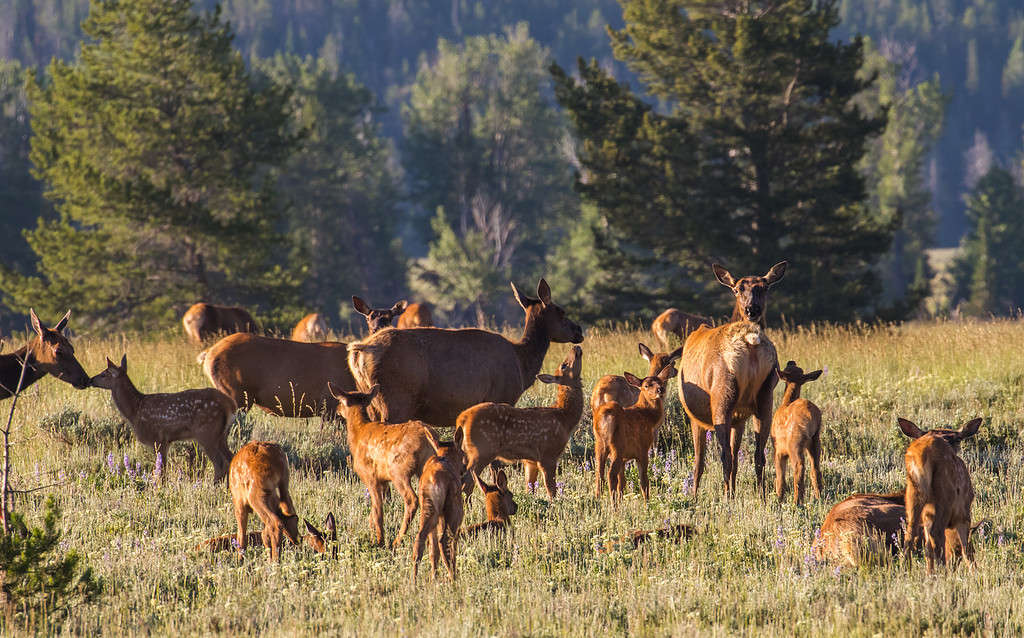The wolf is a common wild canid that lives throughout the United States. Despite the eradication of wolves in California in the early 1920’s, new populations have emerged. Although exact numbers are unknown, at least seven wolfpacks are present in California, with other individuals roaming the state. As the population of wolves begins to increase once again, it’s important that we educate ourselves about these canines. Continue reading for more information on the wolves in California.
Wolves in California

Wolves can thrive in almost any habitat in California.
©Wesam Taleb/iStock via Getty Images
The gray wolf (Canis lupus) is a native species of animal in California. However, they were extirpated in the 1920s. Extirpation refers to the destruction of a mode of propagation, whereas eradication refers to a group of individuals being driven out of an area. The likely reason for this extreme control and removal of the wolf population was to control predation on other animals.
The original male wolf that started the reintroduction of wolves in California appears to have been born in Oregon in 2009. The wolf, known as OR7, eventually made his way into California along with others, though temporarily. Although OR7 made his way back to Oregon, his presence was notable as the first wild wolf to be seen in California in decades. Slowly but surely, more wolves made the trek from surrounding areas to begin recolonizing the Golden State.
Known Habitats

Gray wolves
can form packs that are usually around seven to eight individuals.
©Nagel Photography/Shutterstock.com
The wolf population in California is highly monitored, and so far, seven wolf packs have been identified, though not all have names yet. Wolves are highly adaptable animals and can live in mountainous regions, forests, deserts, and even in urban areas. The wolf packs in California are in Lassen, Plumas, Tehama, Siskiyou, and Tulare Counties, which are all in the northwestern part of the state. They include the Whaleback Pack, Lassen Pack, and Beckwourth Pack.
Fortunately, there is some record that the wolves are reproducing. Two of the seven wolf packs have had litters of puppies each year, with the Lassen and Whaleback Packs having litters since 2017 and 2021, respectively. Some unnamed wolf packs are also reliably reproducing.
Diet and Behavior

Elk and deer are common prey animals for wolves. They make relatively easy meals when pack hunting.
©SBTheGreenMan/iStock via Getty Images
Wolves, like other canines, are primarily carnivorous though they might opportunistically eat fruits or plants. A wolf’s diet could also depend on its location and the season. Their primary targets tend to be large prey animals, like elk or deer. However, their primary diet relies heavily on smaller mammals. Rabbits, hares, rodents, or beavers are common staples in a wolf’s diet, though birds, fish, and reptiles might make their way in there, too.
Seasons also play a role in diet. If their preference is not widely available during a given season, wolves might resort to other options. This could mean eating carcasses, trash, or attacking livestock. Instances of wolves treading near human territory are more common in areas with a higher wolf population. Fewer natural areas for hunting and habitation forces them toward urban areas.
Risk to Humans

Wolves can be especially aggressive towards dogs.
©otsphoto/Shutterstock.com
Wolf attacks are fairly rare, with only about 18 reports of wolf aggression towards humans taking place in the last 40 years in California. Although wolves tend to avoid humans, instances where a human and/or pet encounters a wolf have occurred. Here are some tips to avoid a potentially dangerous encounter with a wolf:
- Do not feed or approach the wolves.
- Avoid eye contact or running if you encounter one.
- Throw something at the wolf or make loud noises while slowly retreating to safety.
- Avoid touching the carcass of a wolf without gloves and wash properly after contact. Wolves can carry parasites like tapeworms that might pass to humans.
In California, gray wolves are an endangered species and cannot be harmed or captured, even if you’re defending a pet. To avoid a run-in with a wolf while you’re out with your dog, you can do some of the following:
- Use collars with bells or other noise-making accessories to deter wolves.
- Make your presence known by talking loudly.
- Use leashes when walking your dog and keep them close to you.
- Avoid walking at night with your pet if possible.
Conservation
California is taking steps to conserve the endangered wild wolf population recolonizing the state. One of the main tactics of conservation lies in reducing wolf-livestock conflict. These conflicts can be devasting to small-scale ranchers if they lose their livestock to wolves. Increasing populations of wolves can make ranchers very wary, but organizations like the California Wolf Foundation are actively coming up with ways to avoid conflicts. They even have a livestock loss compensation program to help financially offset loss of livestock related to wolves.
The photo featured at the top of this post is © AB Photography/ via Getty Images
Thank you for reading! Have some feedback for us? Contact the AZ Animals editorial team.







